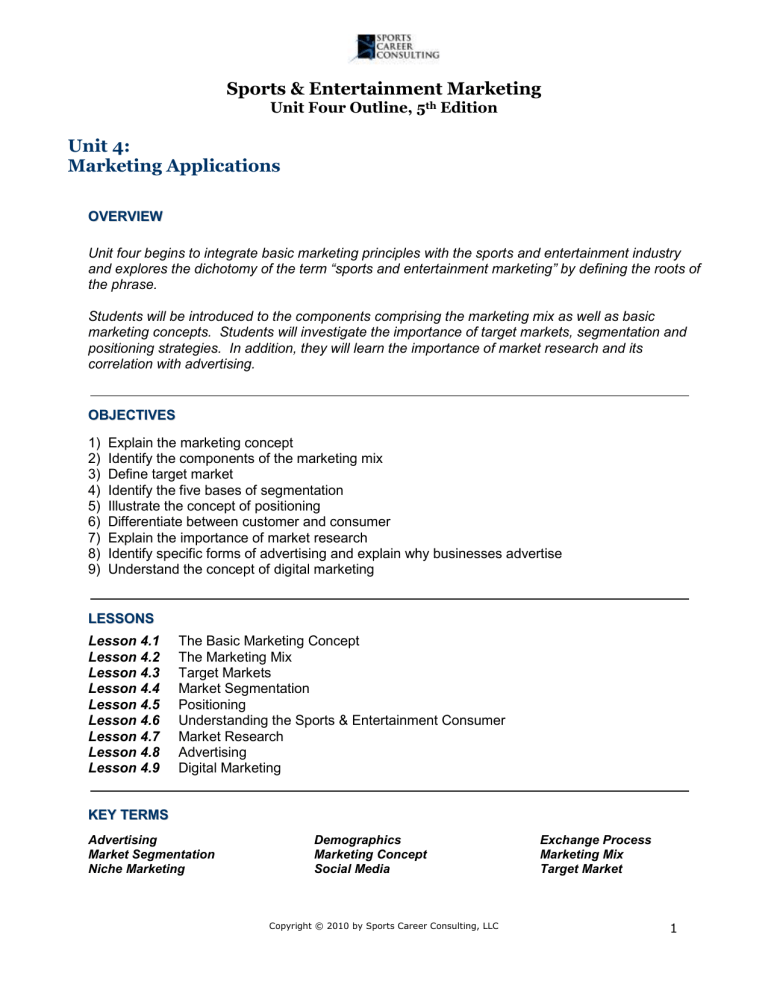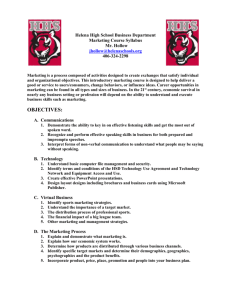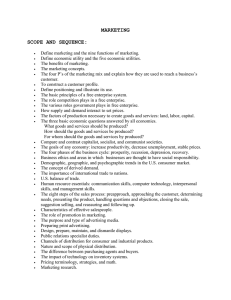
Sports & Entertainment Marketing Unit Four Outline, 5th Edition Unit 4: Marketing Applications OVERVIEW Unit four begins to integrate basic marketing principles with the sports and entertainment industry and explores the dichotomy of the term “sports and entertainment marketing” by defining the roots of the phrase. Students will be introduced to the components comprising the marketing mix as well as basic marketing concepts. Students will investigate the importance of target markets, segmentation and positioning strategies. In addition, they will learn the importance of market research and its correlation with advertising. OBJECTIVES 1) 2) 3) 4) 5) 6) 7) 8) 9) Explain the marketing concept Identify the components of the marketing mix Define target market Identify the five bases of segmentation Illustrate the concept of positioning Differentiate between customer and consumer Explain the importance of market research Identify specific forms of advertising and explain why businesses advertise Understand the concept of digital marketing LESSONS Lesson 4.1 Lesson 4.2 Lesson 4.3 Lesson 4.4 Lesson 4.5 Lesson 4.6 Lesson 4.7 Lesson 4.8 Lesson 4.9 The Basic Marketing Concept The Marketing Mix Target Markets Market Segmentation Positioning Understanding the Sports & Entertainment Consumer Market Research Advertising Digital Marketing KEY TERMS Advertising Market Segmentation Niche Marketing Demographics Marketing Concept Social Media Copyright © 2010 by Sports Career Consulting, LLC Exchange Process Marketing Mix Target Market 1 Lesson 4.1 Basic Marketing Concept Define Marketing Concept Marketing concept is the idea that a company’s ability to sell its products and services depends upon the identification of consumer needs and wants & a successful determination of how best to satisfy them. Why Are Marketing Activities so Important to Business? 1. Financial success is a direct result of a company’s ability to effectively market its products and services. 2. A business achieves profitability when they offer the goods and services that Customers need & want at the right price. 3. Marketers strive to identify & understand all factors that influence consumer buying decisions. Needs vs. Wants A need is something a consumer must have & cannot live without. For example, without food or water you would not be able to live. A want is something a consumer would like to have but is not a basic necessity. For example you might want a New Computer or tickets to New York Jets (The Best Team by The Way) game, but you can survive without them. Exchange Process The exchange process is a marketing transaction in which the buyer provides something of value to the seller in return for goods and services that meet that buyer’s needs or wants. The Exchange Process Has Three Requirements 1. There must be at least two parties involved. 2. Some means of communication must be present between all parties, and typically a desire must be present to engage in a partnership with the other party. 3. Each party must be free to accept or decline How Can The Marketing Process Benefit Consumers? The marketing process serves many purposes and provides numerous benefits for the Consumer. 1. The ability to add perceived value to goods and services 2. Making the buying process easy and convenient for consumers 3. Creating and maintaining reasonable prices 4. Offering a variety of goods and services 5. Increasing production Copyright © 2010 by Sports Career Consulting, LLC 2 Lesson 4.2 The Marketing Mix The Four P’s of Marketing (Marketing Mix) Define Marketing Mix Marketing mix consists of variables controlled by marketing professionals in an effort to satisfy the target market. What Are the Four P’s of Marketing? Product 1. Goods, services, or ideas used to satisfy consumer needs 2. Designed & produced on the basis of consumer needs and wants Price 1. Determined by what customers are willing to pay and production costs. Place 1. The process of making the product available to the customer. 2. Marketers must identify where consumers shop to make these decisions. 3. Careful consideration is given to determining the distribution channels that will offer the best opportunity to maximize sales. Promotion 1. Information related to products or services are communicated to the consumer. 2. Marketers determine which promotional methods will be most effective Copyright © 2010 by Sports Career Consulting, LLC 3 Lesson 4.3 Target Markets Before we examine target markets, we must first understand what determines a market 1. The group of potential consumers who share common needs and wants. 2. That consumer group must have the ability and willingness to buy the product. 3. Businesses strive to meet the needs and wants of those consumers. Define Target Market A target market refers to people with a defining set of characteristics that set them apart as a group. The target is a specific group of consumers with a defining set of characteristics. This market shares one or more similar and identifiable needs or wants. Considerations When Evaluating a Target Market: Sizeable 1. The size of the market. 2. Market can have too many or too few consumers. Reachable 1. Ability for marketers to reach consumers. 2. Marketer must have a means for communicating with target group of consumers. Measurable & Identifiable 1. Is talking about the ability to measure size, accessibility and overall purchasing power of the target market. Behavioral Variation 1. Marketers seek to find similar behaviors within each respective target market. 2. For example, motivation of buying for the corporate season ticket holder is different than for the individual season ticket holder. Target Market Strategies Are Influenced by Several Factors. What Are They? 1. Diversity of consumer needs and wants. 2. Organization size. 3. Attributes of company products and/or services. 4. Size and strength of competitors. 5. Sales volume required for profitability. Niche Marketing Define Niche Marketing Niche Marketing is the process of carving out a relatively tiny part of a market that has a special need not currently being filled. Cable television channels often seek niche audiences to appeal to specific target groups with a common set of interests. Niche marketing often offers a unique opportunity to consumers or one that has not been offered in the past. Copyright © 2010 by Sports Career Consulting, LLC 4 Lesson 4.4 Market Segmentation Market Segmentation Define Market Segmentation Market segmentation is the process of identifying groups of consumers based on their common needs. Segmentation is the first step toward understanding consumer groups as it assists in determining target markets, the marketing mix and developing positioning strategies. Segmentation is important because it allows businesses to customize their marketing mix and strategies to meet the needs of the target market. Bases for segmentation Demographic What is Demographic Information? Demographic information provides descriptive classifications of consumers. Demographic Information Focuses on Information That Can be Measured. 1. Age 2. Income 3. Household statistics 4. Occupation 5. Gender Product Usage Reflects what products consumers use, how often they use them, and why they buy said Products. Psychographic Grouping consumers based on personality traits & their lifestyle. Benefits Refers to a perceived value consumers receive from the product or service. Geographic Dividing of markets into physical locations Sports consumers are characteristically loyal to particular regions when making purchase decisions Copyright © 2010 by Sports Career Consulting, LLC 5 Lesson 4.5 Positioning Positioning Define Positioning Positioning is the fixing of a sports and entertainment entity in the minds of consumers in the target market. Positioning also refers to the place the product occupies in consumers relative to competing products. Positioning Strategy Products or services are grouped together on a positioning map. Products or services are compared and contrasted in relation to one another. Marketers must determine a position that distinguishes their own products and services from competitor products and services. Selecting a Positioning Strategy Identify all possible competitive advantages Includes: Products, services, channels, people or image can be sources of differentiation Organizations often position their products relative to competitor weaknesses. Choose the right competitive advantage. Positioning Errors to Avoid 1. Which differences to promote? 2. Are the differences legitimate? Product Differentiation Define Product Differentiation Product differentiation refers to a positioning strategy that some firms use to distinguish their products from those of competitors. Re-positioning Define Repositioning Re-positioning is a marketer’s plan for changing consumers’ perceptions of a brand in comparison to competing brands. Copyright © 2010 by Sports Career Consulting, LLC 6 Lesson 4.6 Understanding the Sports & Entertainment Consumer Customer vs. Consumer The customer is the individual who buys the product or service. The consumer is the individual who uses the product or service. The customer can also be the consumer. Who is The Sports & Entertainment Business Consumer? Marketers sell sports and entertainment participation. Who are The Sports Consumers? Sports consumers are people who may play, officiate, watch, or listen to sports, or read, use, purchase, and/or collect items related to sports. Could also include: 1. Manufacturers 2. Resellers 3. Sports Governing Bodies Sports Consumers Participate in The Exchange Process in Two Ways. Spectators as Consumers Benefit by watching the event or game. Exchange for tickets and entertainment. Participants as Consumers Benefit by playing, competing, or participating in the event. Exchange for equipment and/or participation. Copyright © 2010 by Sports Career Consulting, LLC 7 Lesson 4.7 Market Research Market Research Market research is the process of systematically collecting, recording, analyzing, and presenting data related to marketing goods and services. Market research provides an opportunity for companies to get to know their customers. Marketing research gathers information pertaining to: 1. Consumers 2. Competition 3. Company 4. Culture/climate The information gathered through marketing research is used to: 1. Form links between consumers and companies 2. Identify and define marketing opportunities and potential challenges 3. Generate, refine, evaluate and monitor marketing activities 4. Analyze and understand the company, its industry and its competition What Are The Four Steps in The Research Process? 1. Identify the problem, concern or additional desired information to be gathered. 2. Select and design research. Primary research is the original research conducted for a specific marketing situation. What Are Examples of Primary Research? 1. Surveys 2. Direct mail 3. Telephone 4. Interviews 5. Focus groups Secondary research is published data that has been collected for some other purpose. What Are Examples of Secondary Research? 1. Census reports 2. Demographic analyses 3. Trade associations 4. State agencies 5. Commercial research firms Collecting Data A census is a method used for obtaining statistical information that counts every member of a population. A sample is a method for accumulating statistical information that is only obtained from a subset of a population. Copyright © 2010 by Sports Career Consulting, LLC 8 Report And Analyze Qualitative research data typically involves large numbers of respondents, typically 100 or more, and yields results that are representative of the total population. Quantitative research data is generally gathered in the form of focus groups. Another common form of qualitative research is in-depth one-on-one or two-on-one interviews Communicate results of research. Copyright © 2010 by Sports Career Consulting, LLC 9 Lesson 4.8 Advertising Advertising Define Advertising Advertising is any paid, non-personal form of communication by an identified company promoting goods and services. List Five Examples of Different Advertising Formats. 1. TV commercials 2. Print advertisements 3. Direct mail 4. Internet (banner advertising, “pop up” ads) What Role Can Advertising Play in Helping Marketers Achieve Their goals? 1. Effective communication 2. Create awareness 3. Create or change image 4. Associate a brand with feelings and emotion 5. Precipitate behavior 6. Establish and maintain positive public perceptions 7. Assist in the increase in sales Types of Advertising Print media Any written form of communication used to inform, persuade, or remind consumers about products or services offered Outdoor advertising Mass Transit Advertising Uses public transportation, such as buses, bus stands, taxicabs, and subways to post advertising messages. Broadcast media Any visual and/or audible form of communication used to inform, persuade, or remind consumers about goods or services offered. 1. Radio advertising Advertisers match their target market to a radio station that segments a particular market and has the ability to reach a wide audience 2. Television advertising Includes commercials and infomercials. Is typically the most effective type of broadcast media. Is traditionally the most expensive form of broadcast media. Online media Placement of advertising messages on the Internet i. Banner ads, pop-ups etc. Internet advertising is the fastest growing advertising segment in the world i. The Internet was the ONLY medium expected to see an increase in advertising spending during 2009. Copyright © 2010 by Sports Career Consulting, LLC 10 Specialty media Known more commonly as promotional products Includes “everyday” items displaying a company name or logo i. Calendars ii. Pens iii. Magnets iv. Coffee mugs Additional forms of media Marketers often use many other creative ways of communicating advertising messages to consumers i. Blimps 1. Goodyear, Outback, Met One (“Snoopy One”) ii. Supermarket carts and grocery bags 1. Select grocery stores in Oregon offer “eco-friendly” grocery bags ?featuring the Portland Trail Blazers logo Advertising (Ad) And Public Relations (PR) Agencies What is an Advertising Agency An ad agency is an organization that decides on and implements an advertising and marketing strategy for a customer while a PR agency is responsible for determining an effective public relations strategy for each respective client. Why do Companies Work With Agencies? a. Expertise b. Time constraints c. “Fresh” perspectives d. Access to athletes, celebrities, entertainers Questions Organizations Address When Selecting an Agency. a. Does the agency have a solid, comprehensive marketing plan in place? b. Does the agency have comprehensive marketing skills? c. Can the agency effectively determine the target market and find a means to reach them efficiently? d. Does the agency have a track record of success? e. Has the agency worked with others in your industry? Copyright © 2010 by Sports Career Consulting, LLC 11 Lesson 4.9 Digital Marketing Digital Marketing Define Digital Marketing Digital marketing can be described as actively promoting products and services using digital distribution channels as an alternative to the more traditional mediums such as television, print and radio. How Does Clutter Impact Marketers? Marketers today must determine ways to effectively cut through the clutter if the firms they represent are to financially thrive. Digital Marketing Strategies Define Marketing Strategies Digital The Four Primary Types of Digital Marketing Strategies 1. Internet marketing 2. Mobile marketing 3. Social marketing 4. Viral marketing The key goal for digital marketers is to focus on interactive elements, encouraging consumers to actively participate in promotions. Consumer-Generated Media (CGM) CGM originates from: 1. Blogs 2. Message boards and forums 3. Public discussions (Usenet newsgroups) 4. Discussions and forums on large email portals (Yahoo!,AOL, MSN) 5. Online opinion/review sites and services/ feedback/complaint sites TEACHER NOTES Copyright © 2010 by Sports Career Consulting, LLC 12 Copyright © 2010 by Sports Career Consulting, LLC 13



